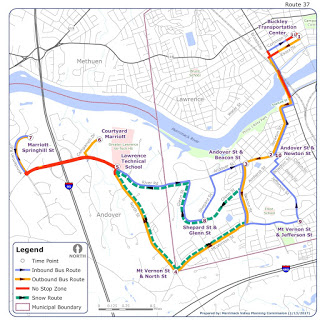RIPTA: 59x (North Smithfield/Lincoln Express Park and Ride)
Okay, so this is the 59x. It’s an express route that runs three trips in each direction every day. And…uh…well, just take a look at the bus it was using…
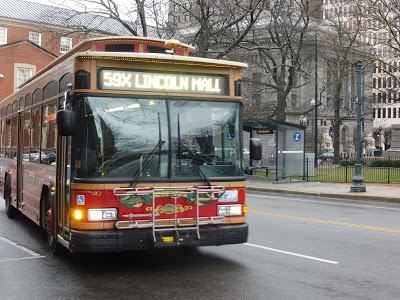 |
| UMMMMMMMMMM… |
Alright, so we’re riding a tourist trolley to Slatersville! Uhh…that’s…interesting. How did this happen exactly? Okay, well, our little trolley headed out from Exchange Terrace and we used Francis Street to get onto Memorial Boulevard. We curved around the Providence Place Mall on a ramp leading to I-95 North, but after passing a few downtown Providence buildings and landmarks, we took an exit onto Route 146.
 |
| Just a part of the sprawling Providence Place Mall. |
Route 146 got pretty woodsy pretty quickly, with only brief flashes of civilization whenever we traversed an overpass. We were travelling along the route of the 54, but luckily, we didn’t have to do its deviation to Twin River Casino and CCRI. However, we did have to do its Lincoln Mall deviation, so we took the exit onto George Washington Highway.
 |
| This is a weird part of the mall… |
Ah, but it wasn’t just a Lincoln Mall deviation. No, this was a Lincoln Mall Park and Ride deviation! Yes, we made our way to the back of the mall to just randomly stop in the middle of the parking lot, and this was apparently a stop, and almost everyone on the bus got off. Okay…so you’re telling me that the main reason most people use the 59x is so that they don’t have to walk to the other side of a mall. Huh. Also, I’d just like to remind everyone that we’re in a tourist trolley!!
 |
| Coming from behind the mall. |
We returned to Route 146 after that deviation, and after an interchange with I-295, the highway became just a regular road with a bunch of suburban businesses along it. We soon merged onto Route 146A (Smithfield Road), but we got to skip the 54’s Walmart deviation, which was kinda nice. There were some more suburban businesses before Smithfield Road turned to the dense houses of Woonsocket.
 |
| The shopping center into which the 54 deviates. |
This was not a Woonsocket express, though. The 54 left us to go down Providence Street towards downtown Woonsocket, but we stayed on Smithfield Road, which had a section where it was just woods and a cemetery. Houses did eventually come back as the street became Great Road, but they were more spread-out and suburban.
 |
| A cool view from the woodsy section. |
We went through a place called “Branch Village,” but it seemed to just be a few businesses with parking lots and a driveway to an industrial building. After that, we went over Route 146, and the road now had houses alongside it again. It became Victory Highway, there was a brief section of forest, and we finally deviated into Slatersville Plaza, our last stop.
 |
| A tourist trolley in Smithfield. I never thought I’d see the day. |
RIPTA Route: 59x (North Smithfield/Lincoln Express Park and Ride)
Ridership: My trip got six people. Four of them got off at Lincoln Plaza. One of them got off at a random stop that they could’ve taken the 54 to. So…one person took the 59x for its independent section. That’s not great.
Pros: It skips some 54 deviations. That’s nice.
Cons: To me, this route just feels redundant to the 54. Considering that five out of the six riders on my ride could’ve theoretically used the 54 instead, why not just…put them on the 54? I think that route can handle an extra five people. As for the one person…well, maybe the 59x doesn’t need three trips in each direction per day. Maybe it only needs one.
Nearby and Noteworthy: Slatersville Plaza has…a supermarket. And a Subway. And a Rite Aid. Okay, yeah, it’s boring.
Final Verdict: 2/10
Considering how many resources it takes to run three one-way express trips in the peak direction only, this route could easily be scaled back. I mean, that’s three separate buses that all have to be deadheaded in one of the directions, and it they’re each carrying riders in the single digits, most of whom could just use the 54, then I don’t see the point in running the route! Maybe it could have one trip to get North Smithfield people, but even then, I don’t know if that’s worth it…
Latest MBTA News: Service Updates
RIPTA: 9x (Pascoag)
Finally, we’re going back to civilization! Sorry, all that Woonsocket and Burrillville stuff was starting to wear me down. Let’s just take the 9x back into Providence!
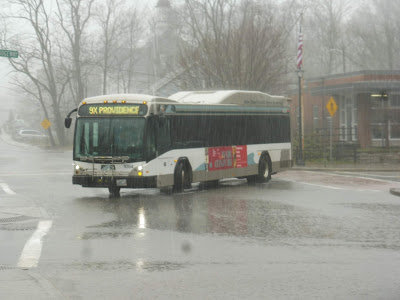 |
| Oh man, that rain is a-comin’ down! |
It was pouring, so the bus was a very welcome sight as we waited in the surprisingly nice Pascoag bus shelter. We got on, and the bus looped around onto Pascoag Main Street, running past dense businesses as we got further from the town center. We soon passed through a cemetery, and then we entered a section of woods as the road became Chapel Street.
 |
| These photos aren’t gonna be very good… |
The houses started to get really dense and we entered Harrisville, a fairly large downtown with a few businesses and some apartment buildings. We turned onto Central Street, which soon devolved back to sparse houses, and it stayed that way until we headed down Victory Highway. This was Mapleville, and the dense homes were back, although there was only a country store on the retail front this time.
 |
| Woods woods woods. |
Victory Highway curved away from Mapleville and it became far-apart houses once again. We used Lapham Farm Road to get onto Broncos Highway, which wasn’t a true “highway,” but it was a fast-moving road. It took us by a pond and a golf club, then, when we entered Glocester (finally leaving Burrillville!), the road just became Victory Highway again.
 |
| Coming onto Broncos Highway. |
We went by some farms, and soon after, we merged onto Putnam Pike as we entered Chepachet. This was a little town with some businesses, a few churches, and a library. I do mean little, though – it was over quickly, and once we left the downtown, we went by a cemetery and some suburban businesses with parking lots. They weren’t big ones (think CVS and Dunkin’ Donuts), but it was a sign that we were getting closer to civilization.
 |
| That’s a…dangerously large puddle. |
But, as was getting typical for this route, we eventually reentered the woods, but instead of just houses breaking up the trees, there were also a few random businesses that popped up. There was a little village called Harmony that was basically just a library and a fire station, then we passed a golf club and a few businesses. Next, the road travelled past the Waterman Reservoir, and there were a few apartment developments on the other side as we entered Smithfield.
 |
| The reservoir! |
We came into the village of Greenville next, and this one felt a little more suburban and sprawled-out than some of the dense, compact towns we had seen before. Most of the businesses had parking lots that were bigger than the building itself, which was sad to see. There were some houses past the village, then it got truly sprawly, with proper shopping centers with parking lots.
 |
| Ehhh… |
Believe it or not, we actually deviated into one of them. Yes, we got to serve a Stop & Shop. Wooooo. From there, we looped around onto Commerce Street, passing some industrial buildings before arriving at the tiny Smithfield Park and Ride. By tiny, I mean just 20 spaces! After going by that little lot, we returned to Putnam Pike and its suburban shopping plazas.
 |
| Going by the Stop & Shop again. |
We suddenly merged onto I-295, and it was time to express into Providence! All we could see was trees and trees and trees, but as the highway came into Johnston, there were a few big suburban businesses that could be seen from some of the overpasses. We merged onto Route 6 next, where the scenery was basically the same at first.
 |
| A shopping center. |
Once the highway entered Providence, though, it was dense houses galore. Just south of Olneyville Square, Route 6 curved north, and we ran alongside the Northeast Corridor as it got more and more urban. Finally, we took an exit onto Exchange Street, which had an industrial feeling. Once we went under I-95, though, it was suddenly the heart of Providence. We turned onto Sabin Street, reaching our first stop on the route’s loop around the city, the Rhode Island Convention Center.
 |
| Some industrial buildings, seen from Exchange Street. |
We turned onto Empire Street next, which went by both restaurants and municipal buildings. From there, it was a left onto Weybosset Street, going by the Providence Performing Arts Center and Johnson and Wales University. We then entered the financial district, and there were office buildings everywhere as we turned onto Exchange Street. This took us past Kennedy Plaza, and after that, we turned onto Exchange Terrace, reaching our final stop.
 |
| Our same bus heading outbound again. |
RIPTA Route: 9x (Pascoag)
Ridership: Considering that our inbound trip in the evening got seven other riders, I’ll bet the peak ridership on this thing is even better. And sure, seven people isn’t that much, but again, this is an inbound trip leaving at 3 PM from the middle of nowhere. It’s kind of a lot when you think about it that way.
Pros: Barring the 282 (which doesn’t count anyway), this is the only real transit that Burrillville has, and it’s probably the most populated town in Rhode Island that’s not served by any decent bus routes. However, the 9x is an express, and on that front, it’s actually pretty good, and it runs much better service than many of RIPTA’s other expresses. It runs in both directions throughout the day, and aside from the peak service (three trips for each rush, which is typical), there’s a “midday” run that leaves Providence at 1:40. Okay, it’s not great, but it’s something.
Cons: This part of Rhode Island needs better service, there’s no doubt about that. I don’t think the 9x is the route to give all-day service, since it’s going to A) cost a lot of money to run because the route is so long, and B) be really infrequent (as in more than every two hours), again because the route is so long.
Nearby and Noteworthy: Heck, Providence is nearby and noteworthy! Give the people up in Burrillville a taste of the urban life, even if it’s just a small city in the shadow of Boston (you know it’s true)!
Final Verdict: 7/10
Yeah, for an express route, the 9x does its job just fine. Burrillville needs better transit, but all-day service on the 9x would be infrequent and expensive to operate. Instead, see my plan on making the 282 a fixed route. That uses the same amount of resources being used now, and it would run at least under every two hours.
Latest MBTA News: Service Updates
RIPTA: 282 (Pascoag/Slatersville Flex)
This is the complete and utter wrong type of route to run as a flex. “Where you going?” the driver asked when Sam and I got on the 282 at its Walmart timepoint. “Sayles Ave,” I responded. “Where the 9x stops.” “I don’t know where that is,” the driver responded. “Just hit the button when you want to get off. It’s just like a big bus.” Okay…but then why is it a flex?
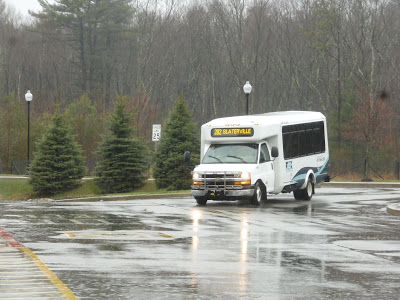 |
| It actually pulls into Walmart, unlike the 54, which stops on the road next to it. |
We headed out from Walmart onto Route 146A, which merged into Route 146. We did a u-turn to get onto 146 North, and from here, we had an express section (believe it or not), running through the woods on this highway. We eventually took an exit, making a left onto School Street after the ramp.
 |
| A view from the highway. |
Considering what we had been going through on the highway, this area we were passing through now could be classified as “dense.” I mean, the houses were kinda close together, and there were actually a few businesses here and there. We even passed a few big apartment complexes, so that’s pretty significant. One of them was in an old factory, and this was one of the attractions of “North Smithfield Center,” the others being a town green, a church, a post office, and even a few businesses.
 |
| The church in North Smithfield. |
Continuing onto Main Street, the dense houses near the center started to thin out, but we did also go by another apartment complex before coming up to some suburban businesses at the intersection with Victory Highway. We turned onto this, speeding past some homes and then a bunch of woods, entering the geographically huge town of Burrillville in the process. We soon turned onto Old Nasonville Road, which passed through a small residential neighborhood, and then it was a left back onto Victory Highway, but it was less of a “highway” at this point and more just a regular road.
 |
| Darn this rain, making these pictures awful! |
Victory Highway was fairly industrial at this point, although there was some retail here and there, too. We maneuvered on Douglas Turnpike for a bit, only to continue down Victory Highway, which was forest before we spilled out into Nasonville, a small neighborhood with some reasonably dense houses and a post office. After going over the Branch River, the road went back to woods.
 |
| I think this is the Branch River? Truth be told, I’ve kinda lost track among these blurry pictures. |
Our next point of interest was the Burrillville Police Department, and there were some legitimately dense houses after that. We went over the Clear River, then we turned onto Central Street just north of a post office and a “Country Store.” The houses got sparser along here, but it didn’t feel like the middle of nowhere – they weren’t far enough for that.
 |
| Some houses that are pretty close together. |
We came into a place called Harrisville, and this was our biggest downtown yet, with a ton of houses, some big apartment buildings, some businesses. and even a theater. We actually deviated to the town’s library, because…we were picking someone up! Of course, he would’ve had to call in at least the day before to schedule this trip, which is not at all optimal, but yes, we were getting a passenger.
 |
| Outside of the library. |
We came out of the library and turned onto Chapel Street, which left Harrisville and changed to far-apart houses again. Going through a cemetery, we came out next to an apartment building, then there were some dense businesses as we came down what was now called Pascoag Main Street. We turned onto Bridge Street, which did in fact go onto a bridge over a river, then we turned onto Sayles Ave…in the opposite direction of the 9x stop! Uh-oh…
 |
| HEY! |
The driver turned around. “You gotta get off,” she said. “I’m going to the hospital to take a break, and I can’t bring you with me.” “But we wanted to go the other way down Sayles Ave,” I said. “Well, you shoulda hit the button,” the driver responded, and with that, we were out in the insane downpour. Time for a miserable walk back to town…
 |
| SCREW YOU!!! |
RIPTA Route: 282 (Pascoag/Slatersville Flex)
Ridership: Just the one guy. And honestly, I can’t see many people using some of the scheduled stops on this thing (we’ll get to that), so the only use for the 282 is if you call in a day in advance. Because everyone wants to do that.
Pros: I’m gonna go on a limb and say that Burrillville is the most densely-populated part of Rhode Island that doesn’t have any all-day transit service. Yes, there is the 9x, which has one semi-midday trip, but for all intents and purposes, this area has nothing. So, in that sense, this route plays a big role in providing baseline transit service to Burrillville, but…
Cons: This is just bad. Obviously, most people are going to be calling 24 hours in advance to ride this, but let’s just see why the three scheduled timepoints don’t work either. The one at Sayles Ave (the real Sayles Ave, where the 9x stops) is the least egregious, since it does at least time with the 9x, but it’s completely useless for commuting, since it times only with the latest morning rush trip and the earliest evening rush trip. I guess most of the zone duplicates the 9x, though, so it doesn’t matter anyway.
The next timepoint is the hospital that the driver was talking about. It’s this small medical center in the middle of the woods way outside the Flex Zone, but that’s a useless timepoint, too! The first time the bus stops there is 8:45, but you can’t actually get up there with that, because the route itself starts at 8:45. That means you have to wait for the 2:40 timepoint, and then you’re stuck up there until 5:10.
Finally, there’s the Walmart timepoint. Based on the map, Walmart isn’t in the Flex Zone either, so you can only get to it during its scheduled times, of which there are two: 11:00 and 1:40. So…two hours and forty minutes at Walmart. I feel like even the most rabid shopaholic couldn’t spend that much time at a Walmart. So anyway, yeah…you basically have to call in 24 hours in advance to use this route for anything. It doesn’t help that this long, skinny Flex Zone probably doesn’t translate well to zippy service when you want it:
Nearby and Noteworthy: As an outsider, I kinda just wanted to leave these depressing-looking micro-towns. Sorry!
Final Verdict: 2/10
Okay, it’s time for that classic game of “Turn the Flex Route into a Fixed Route”!
I basically tried to create a route that serves as much as possible without having to snake or deviate too much. I omitted the hospital because it’s really far, and the people who are going there could likely use paratransit anyway. So, with that in mind, we end up with a route that operates every 90 minutes. It’s not optimal, but a fixed route running that often is still so much better than a Flex route where you have to call in a day in advance…at least in my opinion. Also, 90 minutes is an actually reasonable amount of time to spend at Walmart!
Latest MBTA News: Service Updates
RIPTA: 281 (Woonsocket Flex)
“Didn’t you used to live in Kingston?” the woman on the Flex line asked. “Uhhhh…yeah,” I responded. Why does it have to be so hard to call for a Flex ride? “I want to go from Price Rite to the North Smithfield Stop & Shop,” I said. “I’m sorry, I need exact addresses,” the woman responded. Oh, but I was prepared this time! I had written the addresses on a notecard before making the call! HA! Let’s ride the 281.
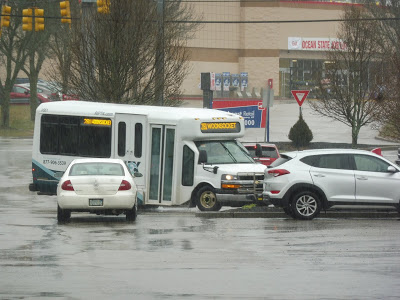 |
| The minibus entering the Price Rite parking lot. |
 |
| Houses. |
 |
| The bleak ol’ river… |
 |
| Bye! |
RIPTA: 87 (Fairmount/Walnut Hill)
“Fairmount/Walnut Hill”? What the heck is that supposed to mean? No, we need to refer to the 87 like it really is: “Loopy Woonsocket Circulator.”
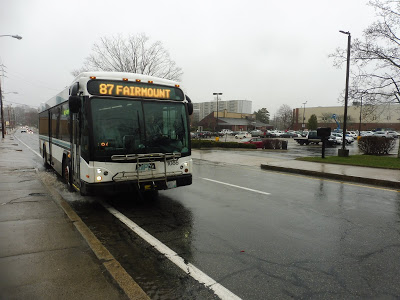 |
| The other bus on the 87 was using a trolley. We just got the boring ol’ regular bus. |
The 87 essentially runs in a loop on its western end, and luckily, the terminus of the 54 is right at the start of that loop. Sam and I got on the bus on Social Street, passing lots of suburban businesses with huge parking lots before merging into Main Street and entering downtown Woonsocket. Like I’ve said before, it…wasn’t much.
 |
| Pretty deserted. |
We were about to go over the Blackstone River like the 54, but just before, we turned onto River Street, which ran alongside the river instead. Other than that, there were mostly dense houses along here, at least until an industrial area where we turned onto Fairmount Street. It was here that we crossed over the Blackstone River, entering another dense residential area.
 |
| Is this gloomy because of the weather or the scenery itself? Or both? Probably both. |
We turned onto 9th Street, which took us to an apartment development. This was the route’s “last stop,” with the bus making its way onto Memorial Drive and looping around. Luckily, since it runs in a loop in this part of town, we only had to lay over for two minutes before heading back out. We retraced our steps as far back as the Blackstone River crossing, but before making it over, we turned onto 2nd Street.
 |
| Inside the apartment development. |
We passed a few apartment buildings, but once 2nd Ave crossed a railroad track, we were in an industrial area. We turned onto River Street, which went over the Blackstone River, then we headed down the narrow Verry Street, which only ran for a block before we merged onto Harris Ave. This became Railroad Street, and it led us back into downtown Woonsocket, where we turned onto Main Street in the same direction to serve the same stops that we had served on the way out. I’ll bet a lot of passengers get asked where they’re going on that section of the route.
 |
| Wow…that’s an industrial area all right. |
We turned onto Bernon Street after downtown, and this took us over another Blackstone River crossing, after which we turned onto Front Street. We passed an apartment building and a few dense houses, then it was time to head down Court Street over the river again. From there, it was a right onto Clinton Street, which turned into suburban businesses with big parking lots pretty quickly. Soon after passing the terminus of the 54 (and our original starting point), we turned onto Cumberland Street.
 |
| Oh look, it’s the trolley! See, I wasn’t lying! |
We went by some apartment developments, then we turned onto Cass Street, which went by the Landmark Medical Center. And then from there…well, the route gets a little crazy. Let’s just run through the tiny streets we travelled down for a few seconds at a time: Sweet Ave (dense houses), Elm Street (ditto), Florida Street (same), Robinson Street (entering an apartment development), Morin Heights Boulevard (another one), Linden Ave (back to dense houses). Okay, great.
 |
| Some of those dense houses. |
We then turned onto Diamond Hill Road, which took us to Walnut Hill Plaza. This got a deviation, of course, and then we returned to the road for just a little bit longer before deviating into the next shopping plaza over, Diamond Hill Plaza. That was our final stop!
 |
| Man, that rain’s really coming down! |
RIPTA Route: 87 (Fairmount/Walnut Hill)
Ridership: I guess for a circulator, ridership was okay: 10 people throughout the ride. I’d imagine that’s about normal for this one.
Pros: Woonsocket is definitely a sizeable enough city to deserve a fixed route, and this one does its job alright for being the only local bus within a town. Alright.
Cons: Boy, the routing gets pretty crazy at times, huh? Not as bad as other routes in other places, but it’s certainly noticeable. Also, the schedule is…weird. In the morning, it uses two buses, allowing for alternating headways of 28 and 32 minutes. That might just be one of the most annoying things I’ve ever seen in my life. But anyway, in the afternoon and evening, a third bus is added, and service becomes every 25 minutes. I’m not sure why that happens, but it happens. And then, on weekends…every 75 minutes. Yeah…that’s a big jump right there.
Nearby and Noteworthy: Some really boring shopping centers. Woohoo!
Final Verdict: 4/10
This reminds me of the MART Gardner Shuttle. Depressing, hilly, industrial city? Check. Weird, loopy circulator route that somehow still gets a decent amount of people? Check. Strange schedule that doesn’t entirely make sense? Check. So yeah…a 4 seems fitting for this one.
Latest MBTA News: Service Updates
RIPTA: 54 (Lincoln/Woonsocket)
This is a big one! We’re going from Providence to Woonsocket using the only public transit connection between those two cities. The 54 also runs mostly express, which is interesting, but I sure ain’t complaining!
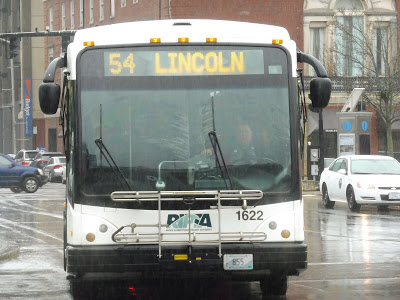 |
| Woahhhhh, up close and personal… |
The route wastes no time. It tells you right off the bat, “I am an express route.” It goes straight onto Memorial Boulevard and onto I-95 right from Kennedy Plaza. It was pretty weird being on a RIPTA route travelling on I-95 north, but we soon took an exit onto Route 146, entering unfamiliar territory for me. This highway ran close to dense residential neighborhoods, but all we could see was trees for the most part.
 |
| The rain allowed for some high-quality pictures, huh? |
We made our way into Lincoln at some point, and soon we took an exit to do our first deviation. Yeah, it’s not a true express, unfortunately – it has to do some off-highway deviations on the way to Woonsocket. This first one was to serve the Twin River Casino, and after passing some nice, rural-looking houses, we pulled into the monstrous parking lot for the gambling house. Yay.
 |
| The casino. |
We made our way onto Old Louisquisset Pike, continuing north past some leafy houses. We then made a deviation to serve CCRI, but after that, we only had to turn onto Jenckes Hill Road before getting onto an on-ramp again. More expressing through the woods!
 |
| Another bus boarding at CCRI. |
Our next deviation took us onto George Washington Highway, and we ended up at the Lincoln Mall. This is actually the only all-day bus route that runs directly from Providence to the mall, so this was an important deviation. It was also a mercifully short diversion, and we were soon back on Route 146, going through interchanges with I-295 and with a spur highway.
 |
| In the Lincoln Mall. |
It was after that spur that we entered North Smithfield and Route 146 ceased to be a highway. Now it was your typical suburban road that was impossibly wide and lined with businesses with big parking lots and the occasional unfortunate house. There was a drive-in, though! This was also a short local section, because Route 146 soon became a highway again…but we didn’t stay with it, taking the first exit onto Route 146A.
 |
| A characteristic intersection. |
We turned onto Dowling Village Boulevard to do our next and final deviation, this time to Walmart. Dowling Village Boulevard also served other huge stores, too, so it was a real win-win! We returned to Route 146A (Smithfield Road), passing some more suburban businesses, including a Stop & Shop. Next, we entered Woonsocket and turned onto Providence Street, which was lined with dense, urban houses – a big change from before.
 |
| A side street. |
We turned onto South Main Street, and this went over the Blackstone River. On the other side, South Main Street became just Main Street, and we entered…downtown Woonsocket? Unfortunately, it was just a bunch of drab, mostly vacant buildings. We had to merge onto the one-way Clinton Street, and that was more of the same. The older buildings gave way to newer ones with parking lots, and then we turned onto Cummings Way, reaching our last stop. The downpouring rain didn’t help the charm of the area.
 |
| The bus on its way back to Providence. |
RIPTA Route: 54 (Lincoln/Woonsocket)
Ridership: My trip had 18 people, and interestingly, a bunch of those people actually got on during the local section. So it gets a good amount of riders from Providence, and a good amount on its Woonsocket section! Seems like good ridership to me!
Pros: For the one connection between Providence and Woonsocket, the 54 does its job well. I like how it’s mostly express, and the deviations all seem to get at least some people. The schedule is also great: every half hour on weekdays, every 45 minutes on Saturdays, and every hour nights and Sundays. Service runs late into the night, too, until midnight on weekdays and 11 PM on weekends.
Cons: Of course the route has RIPTA layover syndrome, amounting to 25-30 minutes on all days. This is especially funny on weekdays, when buses pull up to Cummings Way three minutes after the previous one to Providence has left! Also, the schedule has these trips that have always baffled me. For example, there are two 12:25 departures from Providence on weekdays, and both 1:13 and 1:17 trips from Woonsocket. Where are these buses coming from? As it turns out, these are pullouts and pullbacks of the 87 (Woonsocket’s local circulator) that are going to or from Providence. I guess that makes more sense…
Nearby and Noteworthy: I wasn’t impressed with Woonsocket’s drab downtown, although in its defense, this is a city that’s in pretty hard times right now. I guess there’s always Walmart…
Final Verdict: 8/10
The 54 is a fantastic connector to Woonsocket from Providence, as well as from Woonsocket to places like Walmart and the Twin City Casino. It’s pretty fast, it has a good schedule, and it serves some busy locations. Also, if you can get one of those weird 87 trips, I’ll bet you’ll have the bus to yourself!
Latest MBTA News: Service Updates
RIPTA: 40 (Butler/Elmgrove)
From the MVRTA 40 to the RIPTA 40! These routes are very, very different. I mean, we’re going from inner-city Lawrence to the Providence East Side. You can’t get much more different than that.
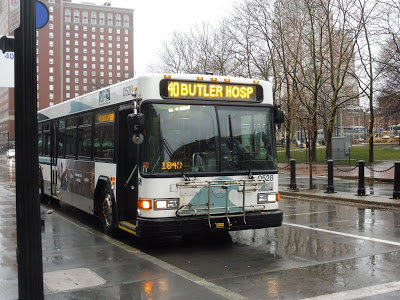 |
| The bus boarding at Kennedy Plaza. |
We of course began at Kennedy Plaza, and like I mentioned before, this is an East Side route. You know what that means? We headed up Washington Street, crossed the Providence River, and entered the East Side Transit Tunnel! YES!!!
 |
| The first thing we saw upon leaving the tunnel. Hi, Starbucks! |
We came out of the tunnel in the Thayer Street area, but we weren’t able to experience its businesses for too long, since we headed onto the mostly residential Waterman Street. However, we did get to experience the businesses of Wayland Square, directly running through the heart of it on Wayland Ave. This was another quick retail section, though, as we soon made our way onto Elmgrove Ave, going by dense but very nice-looking houses.
 |
| Some of those houses. |
There was a small business block, then nothing new until the intersection with Sessions Street. That had Brown Stadium on one corner, a middle school on another, and a Jewish Community Center on a third. It was more houses from there and as we turned onto Rochambeau Ave, which had a really big mansion on it.
 |
| Widest median ever? |
We turned briefly onto Blackstone Boulevard, which had a huge park median. then we headed down Butler Drive. This lovely, woodsy road took us to Butler Hospital, which was quite possibly the nicest-looking hospital I’ve ever seen. It was also our final stop, and I had 22 minutes of layover to kill.
 |
| Hanging out at the beautiful campus. |
RIPTA Route: 40 (Butler/Elmgrove)
Ridership: I rode this route in the morning rush. On the plus side, it got similar amounts of people in both directions. On the minus side, that equated to four riders going out and five coming back in. Ehhh…not great.
Pros: As beautiful as its campus is, Butler Hospital is quite isolated from the outside world, so the 40 is really the only way of getting there without using a car. Of course, like I mentioned, the ridership isn’t great, but the schedule does at least match that: service is weekdays only, every hour. The schedule also touts the route’s interline with the 18, and though the 18’s neighborhoods couldn’t be more different than the 40’s, it’s nice that they make it clear you can stay on to go across town.
Cons: The limited schedule isn’t great, and this probably gets very few people middays. I’d imagine everyone who rides this route on the independent section is heading to Butler Hospital. I will say that this is far more useful than the 49, though, since it actually operates in areas that are far from other transit services.
Nearby and Noteworthy: Man, those 22 minutes were well-spent at the hospital. They have these walking trails that go around the whole campus, and although I wasn’t able to do the whole circuit (the trails aren’t signed too well…), I still hugely enjoyed the walk. I mean…
 |
| It’s like something out of a fairy tale! |
Final Verdict: 6/10
This one is okay. It serves its purpose. If you wanna go to Butler Hospital, you can if it’s a weekday and you’re willing to wait an hour if you miss the bus. But then again…it’s not like it needs to run any more often than that.
Latest MBTA News: Service Updates
MVRTA: 40 (Methuen Square)
The 40 runs in a straight line up Broadway to Methuen Square and beyond. Sounds awesome. Oh wait, no one told me about the deviations…
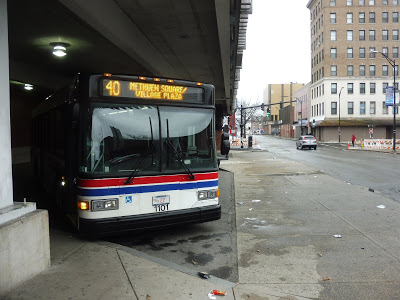 |
| The 40 gets to board in the sunlight! |
We went west down Essex Street, going by lots of retail, which continued as we turned onto Broadway. However, it started to get a little more mixed, with houses coming in between the businesses. For a bit, one whole side of the street was occupied by huge old factories, and then a new shopping plaza appeared as we entered Methuen.
 |
| Just a side street. |
We went over the Spicket River twice, passing more houses and businesses, then we entered Methuen Square, which was…a lot less exciting than I thought it would be. We turned onto Hampshire Street, beginning the route’s long-winded outbound-only deviation – this was the square’s main drag, I guess, but the retail ended quickly. Turning onto Lowell Street, we crossed the Spicket River again.
 |
| Methuen Square. |
There were a few more businesses as we turned onto Pelham Street, but it very quickly turned to houses. We emerged in a strange area with an apartment development, a baseball field, pylons, an MVRTA commuter park-and-ride for its Boston express service, and some suburban businesses. We turned onto Mystic Street from here, and after going under the pylons again, it normalized back to houses.
 |
| Question: why are people parked in the commuter park-and-ride on a Sunday? |
We came back to Pelham Street, ready to finish the deviation, but…oh, there’s a deviation-within-a-deviation onto Barker Street. This was just a little jog to serve some more houses and the Methuen Senior Activity Center. We turned onto Lowell Street, then it was a left onto Hampshire Street, and this finally took us back onto Broadway. We were only on it for enough time to go over Route 213, and then we pulled into Village Plaza, a thoroughly boring shopping center.
 |
| This is kind of a cool view, seen from the deviation. |
So was that it? No, because the route has an inbound-only deviation too! It occurs a little south of Methuen Square, and the route is: right on Oakland, right on Union, left on Railroad, left on Oakland, back onto Broadway. What does it serve? I guess some houses? A few businesses? It’s all within a less than five minute walk from Broadway, so it feels, uh, pretty darn useless.
 |
| Oooh, an old railroad station! |
MVRTA Route: 40 (Methuen Square)
Ridership: The 40 gets good ridership, with 403 passengers per weekday and 224 per Saturday.
Pros: This is the only route to serve Methuen’s main drag and central square, and it’s mostly direct. Also, it has the MVRTA pulse schedule of hourly service seven days a week with half hourly service at rush hour, so that’s good.
Cons: Those darn deviations! The outbound-only one is fairly tolerable, since it does serve a lot and it’s close to the end of the route, but even then, the jog in the middle of it is annoying. The inbound-only one just feels useless, and seems like it could be easily eliminated. Also, good luck trying to get to Methuen Square on time, because at almost every time of day, that trip is gonna take a heck of a lot longer than the scheduled ten minutes.
Nearby and Noteworthy: I’m sorry, but I really didn’t see all that much along here! Maybe Methuen Square has some hidden gems, but it doesn’t seem like a place where you could spend hours walking around in.
Final Verdict: 6/10
The route is…okay. Yeah, the deviations are annoying and the timing is off, but the bus does serve a lot and it seems to get a good amount of people. I can’t hate it too much.
Latest MBTA News: Service Updates
MVRTA: 39B (North Andover Mall/Phillips Street)
How does the 39B differ from the 39A? In a lot of ways, actually! Like, to the point where I’m wondering how you can even justify naming them like that…
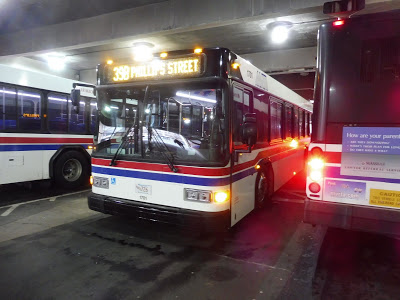 |
| Buses everywhere! |
From Buckley, we made our way onto Common Street, which ran alongside Campagnone Common before hitting up some retail sections. We reached a big factory at Union Street, and as we turned onto that, it generally got more industrial. Crossing a canal and the Merrimack River, we came next to the Lawrence Commuter Rail station, but unlike the 33, we didn’t deviate to serve it. For some reason.
 |
| The canal, because I always seem to use the Merrimack River picture instead. |
We went over the Commuter Rail tracks and turned onto Market Street, going along a park. Next, we turned onto Loring Street, a residential road, and the houses continued as we merged around onto Salem Street, coming up…alongside…the park again. Pretty sure we could’ve taken a more direct route there, but okay…
 |
| Maybe the park is so nice that the MVRTA decided it had to be served twice! |
We turned onto Phillips Street, which was allllllllllll houses until the intersection with Laurel Street, which had an apartment development next to it. And…oh no…we’re not moving…are we…great, we’re four minutes early. LALALALALALA WAITIN’ AT THE STOP!
 |
| The beautiful view for four minutes. |
We went by Plaza 114, but we didn’t serve it, since it wasn’t the 10:00 or 11:00 outbound trip. You know, those trips go into the plaza, but nothing else does. No, instead we just turned onto Winthrop Ave, running past suburban businesses galore and under I-495. We barely entered North Andover with just enough time to pull into the North Andover Mall…one minute early.
 |
| A MVRTA bus outside of Buckley! Wow! |
MVRTA Route: 39B (North Andover Mall/Phillips Street)
Ridership: The 39B gets pretty good ridership for MVRTA standards, although it’s not nearly as high as the 39A: we’ve got 381 passengers per weekday and 212 per Saturday, exactly the average ridership for that second figure.
Pros: The Phillips Street corridor is pretty dense, so it needs a bus service. Also, of course, we’ve got that MVRTA pulse schedule, so service is every hour seven days a week, plus every half hour during the weekday peak periods.
Cons: This route is way too short. It’s scheduled to take 20 minutes to get to the North Andover Mall, and that’s with a lot of padding. Heck, the buses on this route spend 22 minutes just sitting in Buckley! Over a third of the route length is just doing nothing, and that doesn’t include the times when it’s early and it gets to sit for a while anyway!
Nearby and Noteworthy: Most of the route’s independent section is residential, so the biggest attraction is probably the North Andover Mall. And I hate that mall.
Final Verdict: 5/10
Alright, so we’ve got a case where the 39A serves way too many things and the 39B serves way too few. You know what that means? Have the 39B serve some of the 39A stuff! For example, the 39B could absolutely run beyond the North Andover Mall to serve one of the deviations that the 39A has past there. The Plaza 114 deviation is a little tougher to deal with – if the 39A serves it in the same way it currently does, then it makes more sense for the 39B to go in instead, but if the A adopts my suggestion from that post, then that’s more efficient.
Latest MBTA News: Service Updates
MVRTA: 39A (Colonial Heights/North Andover Mall)
Okay, time for a nice direct route to the North Andover Mall! Oh wait, I forgot the MVRTA is incapable of running direct routes. Okay, well, the 39A is still their straightest line to the mall…
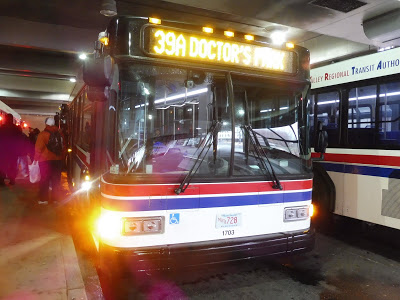 |
| Boarding at Buckley. |
We went straight down Amesbury Street from the Buckley Transportation Center, and it very quickly took us out of downtown Lawrence. We entered an industrial area as we crossed a canal, then we went over the Merrimack River and the road became Parker Street, then we crossed one more canal and went under the Commuter Rail tracks! Finally, past all those crossings, Parker Street now consisted of dense buildings – some houses, some businesses.
 |
| Talk about depressing… |
Parker Street curved slightly southeast and became Winthrop Ave, and it was now mostly houses. We turned onto South Union Street next, then we deviated to serve Plaza 114. This was a clever deviation, though – since the plaza parking lot also goes back to Winthrop Ave, it would allow us to continue the way we were going…oh wait, no, we’re looping around to serve the other side of the plaza. And now we’re coming back onto South Union Street. Okay…
 |
| A foggy dead-end street. |
We turned onto Marlboro Street, a tiny, sidewalkless road with suburban houses. Ditto as we turned onto Durso Ave. And where did that take us? Winthrop Ave, right next to the Plaza 114 entrance. GOOD! So we continued the way we were going, passing some businesses, Lawrence High School, the diminutive Stadium Plaza, and an abandoned Showcase Cinemas.
 |
| On the suburban houses jog. |
We went under I-495 and entered North Andover on the other side, and voila, here was the mall! It took forever to do a deviation into it, and the route was not over yet. No, we still had to perform two extra deviations beyond the mall! We returned to Winthrop Ave and continued our way further into Andover.
 |
| Inside the mall. |
We turned onto Waverly Road, a street that entered Andover proper and became High Street. Soon after that transition, we deviated into Doctor’s Park, a health complex, then it was back into North Andover on Waverly Road. We crossed Winthrop Ave, for our second deviation was on the other side: Woodridge Housing, an apartment development that the bus barely goes into. From there, it was back to Lawrence!
 |
| This is better signage than the entire rest of the MVRTA… |
MVRTA Route: 39A (Colonial Heights/North Andover Mall)
Ridership: This is one of the system’s higher-ridership routes, getting 478 people per weekday and 271 per Saturday. Why does it get so many people? Maybe because it does follow a somewhat direct route and runs the same way inbound and outbound!!!!!!!!!
Pros: Okay, well, that last sentence in the “Ridership” section has two of them. Of course, the 39A also has the MVRTA pulse schedule, meaning there’s a bus every hour seven days a week, and added half-hourly service during peak times.
Cons: For one thing, that Plaza 114 deviation is executed horribly. I really doubt any of those suburban houses on that extra jog generate much ridership, so it would make so much more sense just to have buses travel through the plaza back to Winthrop Ave. Also, what’s the deal with this 39A/39B business? The two routes really aren’t all that similar! On that note, the 39A has a lot more on its plate than the 39B does – I think it would make sense for, say, the 39A to only serve Doctors Park and the 39B to serve Woodridge Housing. Currently, the 39B just ends at North Andover Mall, and it gets back to Buckley with plenty of time to spare as a result.
Nearby and Noteworthy: Two shopping plazas! Wow!
Final Verdict: 6/10
I…guess…it’s…okay…? Hey, for MVRTA standards, running the same way inbound and outbound is certainly an achievement. However, they still don’t know how to run a direct route. Ideally, the 39A would use Plaza 114 to get back out to Winthrop Ave, and that would be a really well-executed deviation! Instead, we have to do the weird jog on random side streets. Plus, the workload of the deviations after the North Andover Mall should really be split between the 39A and 39B – the 39B does nothing while the 39A does everything!
Latest MBTA News: Service Updates
MVRTA: 37 (Beacon Street)
Ah, it’s the Pac-Man route! Seriously. Look at it.
So yes, this is the 37, a wild snaking mess running aimlessly through southern Lawrence and Andover. It serves two Marriotts. Two!
 |
| At least some light is shining in here. |
We went down Essex Street from Buckley, passing brick buildings housing businesses. There were also some apartments where we turned onto Broadway, but this street became industrial quickly. We crossed over an abandoned railroad track after going over a canal, then we crossed the beautiful Merrimack River and its waterfall.
 |
| Awesome! |
There were some businesses on the other side, but we made an instant right onto the residential Shattuck Street. That curved around to become Newton Street, and the scenery was all dense houses, aside from a school in the middle of it all. It was at the intersection with Andover Street where the inbound and outbound routings split up, and we would be apart for a very long time…
 |
| Some of the various houses. |
We approached some suburban businesses at the intersection with Beacon Street, onto which we turned. This was technically joining the inbound route, but the 37 acts like a figure-8, so this was the “combined” middle portion of that loop. Beacon Street had housing developments on both sides, and a shelter outside of a white building attracted a few riders onto the bus.
 |
| The white building. Google Maps won’t tell me what it is. |
Beacon Street’s housing became more suburban after that, and it continued when we turned onto Mount Vernon Street, leaving the inbound route again. As we turned onto North Street and entered Andover, the houses got even bigger and further apart, save for a development at one point. We turned onto River Road at the Lawrence Technical School, rejoining the inbound route.
 |
| Not even sidewalks? Aw… |
We went down River Road for a bit before turning onto Campanelli Drive. This took us through a marsh and up to the…uh…Courtyard Marriott. I see, so this was a deviation? Yup, okay, we’re heading back to River Road now. Fun.
 |
| In the process of doing the deviation. |
River Road got a heck of a lot wider as we crossed I-93, and there were lots of suburban businesses and office parks on the other side. We turned onto Minuteman Road, a street with a huge median serving offices galore that took us to…another Marriott. Okay, then, glad we’ve finished the hotel shuttle portion of the route.
 |
| Yay, Marriott! |
We were now heading back to Lawrence, but we stayed with the outbound route back to Lawrence Technical School (minus that first Marriott deviation). While the outbound route came up to the school on North Street, we stayed on River Road, which quickly got narrow and residential after the school. Once we came back into Lawrence, though, the road became Andover Street, and it was back to office parks.
 |
| There’s a particularly industrial-looking one. |
The route used to do a jog via Glenn and Shepard Streets to serve some of the offices and warehouses, but the MVRTA got rid of it recently, even though it still appears on the map! So, we just stayed on Andover Street, and we soon reached the intersection with Beacon Street again. We turned onto it just like before, and once again, that white building generated a few more people (the ones who got on before had yet to get off).
 |
| Onto Beacon Street again. |
Whereas the outbound route made a right onto Mount Vernon Street, we took a left, passing two water towers and a bunch of houses. Those continued as we turned onto Jefferson Street…and Bowdoin Street…and Davis Street…and Amherst Street…and here we are back on the main route at Andover Street! What a ride, what a ride, back to Lawrence we go!
 |
| The imposing water towers. |
MVRTA Route: 37 (Beacon Street)
Ridership: The 37’s weekday ridership is well above the system average at 361 passengers, but it drops way down on Saturdays to 162 people…well below the system average. My Sunday trip got 6 total people, and they all came from that white building!
Pros: I’m sure the 37 gets lots of reverse commuters on weekdays to those office parks, and it seems to attract lots of residents from the Beacon Street apartments. Also, we’ve got the classic MVRTA schedule, with buses running every hour every day, plus half-hourly service at rush hour.
Cons: Other than the route being a loopy mess? I think the 37’s biggest problem is that it serves so little that actually needs to be served outside of the peak. I mean, I doubt those sidewalk-less suburban neighborhoods are very transit oriented, and of course no one’s going to office parks on a weekend, so Beacon Street is really it. If you’re staying at those Marriotts, you’ve got a shuttle to Lawrence, not that the hotels make any effort to tell you that, or that anyone staying there would be inclined to use a bus, or that anyone staying there would at all want to go to Lawrence. Also, this one is minor, but the 37’s snow route travels in the opposite direction of the regular route for some reason. Yeah, that’s gonna end well!
Nearby and Noteworthy: This post is turning into a Marriott ad. But yeah…this bus serves two of ’em.
Final Verdict: 4/10
There has to be a way this route can be modified outside of the peak to not have to run out to the Marriotts and the office parks every single trip. Do those places generate any ridership middays or weekends? I doubt it! They certainly didn’t on my ride! Of course, shortening the route would affect the pulse back at Buckley, so honestly, there might be nothing we can do. I guess buses will just keep running out to the Marriotts every hour, seven days a week. Gosh, they could at least tell their customers that the bus exists!
Latest MBTA News: Service Updates
GATRA: 16 (Seekonk/Attleboro) – A.K.A. THE BUS FROM HELL
Usually I like to do my reviews in chronological order, but I feel compelled to write this one as soon as possible because this bus route is hell spawn and I’m worried it’ll do something awful to me if I don’t kill it ASAP. Ahem…the GATRA 16, everyone. Time for some context.
 |
| My first encounter with the 16. |
ATTEMPT #1: So my first encounter with this route was over a year ago, when Nathan and I were just trying to take a humble GATRA ride from Attleboro. Our original plan was to do the 14, but that bus broke down, so we decided to do the 16 instead. That bus ended up being 25 minutes late, but at least it did come, and we were able to complete the route. However, just a few days after, GATRA announced that they were extending the route to the Market Basket next to South Attleboro Station (which I apparently gave a 5 – its score should not be that high), a significant enough extension that I decided the route needed to be ridden again. This can all be found in my 70 Minutes in Attleboro post, which concludes with this paragraph:
“NO! GATRA announced that they’re extending the route! I have to ride the stupid thing again! But at the very least, while the route was pretty bad when we rode it, this extension has made it reeeaaaalllyyyyy bad. I look forward to being able to slam it even harder than I would have! Until we meet again, 16…”
 |
| OH MY GOD IT EXISTS!!!!! |
 |
| I hate you. I HATE you. |
 |
| Ha! Bye!!! |
 |
| Some of the houses in the neighborhood. |
 |
| Darn this detour! |
 |
| Not a great menu of stores. |
 |
| A leafy side road. |
 |
| A little garden, I guess? |
 |
| Coming back onto South Main Street. |
 |
| A side street. |
 |
| That’s about it for Central Plaza. |
 |
| Oh, and a mattress shop, I guess. |
 |
| So…close…! |
 |
| I didn’t have time to get a picture of the bus, so here’s us going onto the connector road. |
- ATTEMPTS #1 AND #2: THE BUS WAS REALLY LATE. YES, THE 16 HAS HORRIBLE ON-TIME PERFORMANCE, AND IT DOESN’T HELP THAT IT’S INTERLINED WITH THE 10, ANOTHER ROUTE WITH AWFUL ON-TIME PERFORMANCE. IT GETS NO TIME DURING THE INTERLINE, TOO, SO IT’S ALMOST GUARANTEED TO BE LATE! GATRA NEEDS TO CHANGE THE TIMING ON ALL OF ITS ATTLEBORO ROUTES, I SWEAR.
- ATTEMPT #3: OKAY, THEY HAVE TO BE CRYSTAL CLEAR ABOUT WHERE YOU CAN AND CANNOT FLAG DOWN THE BUS. MVRTA DOES THIS VERY WELL, SHOWING CLEARLY ON THE MAP WHERE THE BUS DOESN’T STOP. DOES GATRA DO THAT????? NOPE, WE LEARN THE HARD WAY: FROM A DRIVER ANGRILY SAYING “NO.”
- ATTEMPT #4: THIS. ROUTE’S. MAP. IS. AWFUL. ROADS THAT DON’T EXIST, COMPLETELY DISTORTED GEOGRAPHY, A MADE-UP ROUTE…AND IT DOESN’T HELP THAT ON GOOGLE MAPS, THE STOP IS SHOWN AT MARKET BASKET. THIS IS SO BAFFLINGLY INCOMPETENT!
- INTERIM ATTEMPTS BETWEEN #1 AND #2: YEAH, REMEMBER HOW I MENTIONED THIS ROUTE DOESN’T TIME WITH ANYTHING? I GUESS THAT’S NOT REALLY ITS FAULT, BUT THIS SCHEDULE MAKES NO SENSE. HERE ARE SOME OF THE WEEKDAY DEPARTURES FROM ATTLEBORO: 8:30, 9:35, 10:28, 11:33, 12:32…YUP, I’M GETTING MWRTA FLASHBACKS! IF THE TIMES ARE GOING TO BE SO FREAKING WEIRD, HOW ABOUT YOU AT LEAST USE REALISTIC RUNNING TIMES SO THE ROUTE ISN’T LATE ALL THE TIME?!?!?!?!?!?!?
MVRTA: 36 (Holy Family Hospital/Lawrence Street)
Time for some loopity-loop-loop-loops on the MVRTA 36! Yeah, this one is rather crazy…as are most bus routes in Lawrence, it would seem.
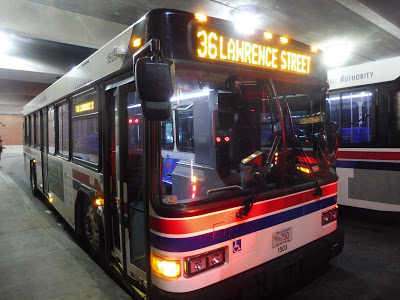 |
| Oh, Buckley…good to be back. |
We headed east from Buckley on Common Street, coming along next to Campagnone Common. We turned onto Jackson Street, then Haverhill Street, circling around the park. At the Lawrence Senior Center stop, we let someone off (a quick trip, but I suppose it’s the senior center), then we reached the end of the common and turned onto Lawrence Street.
 |
| This is…bleak. |
We weren’t on this for very long, banging a left onto Maple Street, which had apartment developments on both sides. It curved around to become White Street, but then we turned onto Elm Street, going by more apartment developments. Next, we turned onto Hampshire Street, which went by the Central Catholic High School and one last apartment development.
 |
| Again…bleak. |
We went over the Spicket River, and from there, Hampshire Street was lined with regular triple-decker apartments (none of that development stuff). I’m not sure why the route goes down Arlington Street just to turn onto Lawrence Street, which could be accomplished just by staying on Hampshire Street, but…yeah, so we did that. It’s an outbound-only jog, no less!
 |
| Apahtments. |
We passed a park and entered Methuen, where though the apartments became houses, the actual spacing of the buildings was just as close. Next to a park, we turned onto East Street, which had some sort of…castle wall along it? It was really cool, and now we were suddenly in a really nice, leafy neighborhood!
 |
| Entering the castle. |
Alright, here we are at the Holy Family Hospital, are we gonna go in…oh, no, we have to do another loop first. So we turned onto the residential Berkeley Street, going briefly back into Lawrence as we served the Berkeley Retirement Home. After that, we turned onto Swan Street, then Jackson Street, reentering Methuen. There were suburban businesses along Jackson, but it turned back to houses when we made a left onto East Street, then deviated up into the Holy Family Hospital.
 |
| These are some nice houses! |
So is that it? No! Because the 36 has an inbound-only jog! For one thing, the inbound route just goes right from Lawrence Street to Hampshire Street, rather than having to do that weird jog that the outbound does. However, it makes up for it later on when it suddenly makes a left on Alder Street, a right on Lawrence Street, and a left on Myrtle Street to get back to Hampshire Street. Why?? Yes, it got a person, but it’s inbound-only, so it’s basically useless! Just use the 85!
 |
| A parking lot. |
MVRTA Route: 36 (Holy Family Hospital/Lawrence Street)
Ridership: Weekday ridership on this route is excellent for MVRTA standards, with 422 riders per day. On Saturdays, it drops down to 207 people per day, which is below the average for the whole system. I took it on a Sunday morning, and it got a round-trip total of 9 people, which isn’t bad for a Sunday morning!
Pros: It serves quite a lot of Lawrence and, to a lesser extent, Methuen, and the 36 has big ridership anchors on both ends: Buckley, of course, and also the Holy Family Hospital. It runs with the MVRTA pulse schedule, meaning hourly service seven days a week, plus additional half-hourly service at rush hour.
Cons: Geez, can the route be any crazier? Actually, I shouldn’t ask that question because I know what insane routes MVRTA is capable of, but still! I get the loop at the end and some of the jogs to serve apartment developments, but I just cannot get behind the inbound- and outbound-only deviations.
Nearby and Noteworthy: There didn’t seem to be much on this route worth visiting. Maybe the castle??
Final Verdict: 6/10
I guess other than the weirdo route, this is a decent one. Still, like I said, this thing is crazy! At least it also serves a lot and gets good ridership – imagine if it didn’t do either of those either.
Latest MBTA News: Service Updates
GATRA: 14 (Attleboro/North Attleboro/Plainville)
So…”Man-Mar Drive” in Plainville. Scenery: a bunch of sketchy-looking businesses inside dated shopping plaza buildings with big parking lots out front. Facilities: a faded old “GATRA Bus Stop” sign bolted to a telephone pole. Morale: low, because the 14 is late and I just want to get out of here!
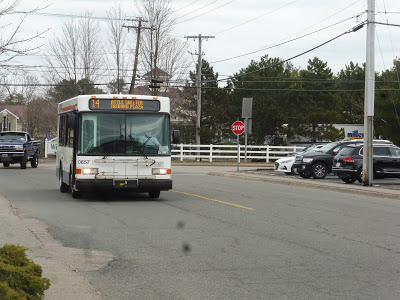 |
| Wow, talk about preemptive door opening! |
 |
| A wide ol’ road. |
 |
| The businesses at South Street. |
 |
| A side street. No one said the retail was interesting… |
 |
| A would-be leafy intersection. |
 |
| Beautiful! |
 |
| The bus…from above. |
Ridership: For GATRA standards, the 14 is a decent route. It gets 147 riders per weekday and 67 on Saturdays, which is about 6-7 riders per trip. Mine only had two other people, but…uh…maybe it was an off day.
Pros: Plainville has just one bus, and that’s the 14. It comes at a handy frequency of every hour, Mondays through Saturdays, and it also serves such attractions as Triboro Plaza and North Attleboro Center. Also, the 14 and the 10 combine to provide half-hourly service to both those places, which is a nice use of resources.
Cons: I’ve realized that this is kind of an Attleboro thing, but the 14 seems to get late far more often than any bus should be. I think this is because of the way they interline routes more than anything, but regardless, it’s annoying. Also, in typical GATRA Attleboro fashion, this route doesn’t get enough time. On Saturdays, for example, they give it 18 minutes from end to end, a trip that usually takes 24 minutes…by car. So yeah, it’s basically guaranteed to be late!
Finally, Man-Mar Drive? That’s where we end the route? Just about 7 minutes up Route 152, there’s a sizeable shopping plaza with a Target and a Stop & Shop, and more importantly, Plainridge Park Casino. I’m sure those would both be huge ridership draws! Sure, this route doesn’t get enough time anyway, but GATRA needs to extend the time of its Attleboro routes anyway. They could use interlining to make things every hour. But that’s a project for another day…
Nearby and Noteworthy: As far as the independent section goes, the 14 really doesn’t serve that much. All it has are some random shopping plazas around Man-Mar Drive.
Final Verdict: 4/10
I mean, if it’s guaranteed to be late, its score can’t be all that high, can it? Not only that, but the route in Plainville doesn’t really serve any high-ridership places. Extending it to the mall and the casino would likely attract a ton of new people to the route! GATRA’s Attleboro schedules would need to be shifted around if that change was made, but truth be told, this isn’t the only route that doesn’t get enough time.
Latest MBTA News: Service Updates
GATRA: Franklin Area Bus
Ahhh, it’s good to be back on a system I know and love! Yeah, you know, I always miss GATRA whenever I’m away from it for a while. It’s so charming in its awfulness, and every GATRA route seems to be full of surprises. While the FAB wasn’t as crazy as the…you know…it was still really, REALLY bad. Time for a FABulous trip!
The Franklin Line was running shuttle buses the weekend Sam and I rode the FAB, and as anyone who has ever taken it knows, that schedule is P-A-D-D-E-D. We arrived at Franklin quite early, and with nothing much to do, we walked around for a bit before hanging out on a street corner downtown waiting for the bus. Except…the 9:50 departure came and went. We made sure to pick a strategic point where we could see the bus do its deviation into Franklin Station and know when it’s coming (because of course, the FAB is a “Give us a Wave!” route, so no stops), but nothing came by. All we saw was a lone dial-a-ride vehicle going the other way.
Well, we had been stuck in Franklin for well over an hour now – it was time to call GATRA and see what the heck was going on. As usual, the “fixed route” extension actually led to the “dial-a-ride” extension, so we had to be redirected. Then, the woman in the fixed route department said that they weren’t responsible for the FAB, and we would have to call Kiessling, who runs the route. “Do you have a pen?” she asked before giving me the Kiessling number. Okay, let’s call them.
ME: Hi, I have a question about the FAB.
MAN: Okay.
ME: I’ve been waiting in Franklin for over an hour now and the bus hasn’t shown up. Do you know what’s up with it?
MAN: Which trip were you waiting for?
ME: The 9:50.
MAN: Oh, it’s a 9:10! That’s the problem!
ME: No, it’s definitely a 9:50. I looked at the schedule.
MAN: No, but we’re running a Saturday service today!
ME: I know, it’s on the Saturday schedule.
MAN: Oh…yes, I see. Okay, let me call the driver.
[unlistenable hold music]
MAN: She said she came through on time.
ME: Oh, really?
MAN: Oh wait, the normal bus wasn’t available today! We had to use one of the dial-a-ride vehicles! Arghhhh, I knew this would be a problem…I’m very sorry. Can you wait for the next trip?
ME: I HATE YOU!
Well, I didn’t tell him I hated him, but I was really upset. It had to have been that dial-a-ride bus going the other way, but why was it going the other way? Sure, the FAB route map is a complete failure in cartography that gives absolutely no indication of a road network, but we were using the map on the Transit App! It very clearly showed the bus deviating into the MBTA station and coming to exactly where we were standing! Same with Google Maps! What was going on?
The FAB runs every 80 minutes on Saturdays, so we had lots more time to enjoy Franklin, which is just not a very interesting town, I’m sorry. For this next trip, we decided to wait at Dean College, since there was a crosswalk right there in case the bus was coming from the other direction. Still, the Transit app clearly showed the route serving the college in both directions, so it seemed like we were good.
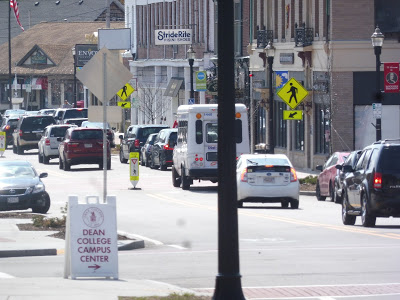 |
| WAIT, WHAT??? |
HANG ON, WHAT’S THAT DIAL-A-RIDE BUS THAT JUST PULLED OFF OF THAT SIDE STREET DOWN THE BLOCK? “WE’RE GONNA GET THAT,” I SAID TO SAM AS I STARTED TEARING DOWN MAIN STREET, TRYING TO CATCH THIS BUS THAT WAS NOT AT ALL FOLLOWING THE ROUTE IT WAS SUPPOSED TO BE FOLLOWING. IT’S A GOOD THING EVERYONE DRIVES IN FRANKLIN (PROBABLY BECAUSE NO ONE KNOWS WHERE THE FREAKING FAB GOES), BECAUSE THE BUS WAS STUCK IN TRAFFIC AND WE WERE ABLE TO CATCH UP TO IT!!!!!!!!!!
We paid our fares and sat down in the vehicle, struggling for breath. “Seatbelts please!” the driver yelled from the front. Sigh…okay, sure, seatbelts are now on. Let’s finally review this stupid route. I don’t know who’s wrong about the routing, GATRA or the driver, but that was inexcusable.
 |
| WE’RE FINALLY ESCAPING! |
We looped around onto Central Street, then we looped onto Emmons Street. We then took a left onto Main Street, running through the Dean College campus before going by the Franklin Public Library, which is apparently the first in America! Next, we reached the Franklin Town Common, making a left onto High Street, then a right onto Union Street.
 |
| Looking down Beaver Street. |
The road became Daniel McCahill Street for a block before becoming Oak Street as we passed the Franklin Council on Aging, strangely without deviating – it only goes in there on weekdays. Maybe the COA is closed on Saturdays, in which case that was a very smart move to not make it deviate then! We then passed the huge Franklin Middle and High Schools before turning onto Panther Way, which…yup, Franklin High School’s sports teams are the Panthers.
 |
| Yay! |
We turned onto Veterans Memorial Drive, which took us to our deviation target, Eaton Place, which is only served in one direction that changes based on the trip. From there, we were supposed to go back to Oak Street, but we abandoned the written route again by continuing down Panther Way. We reached West Central Street and turned onto that, going by a bunch of suburban businesses.
 |
| WE ARE NOT SUPPOSED TO BE HERE. |
We deviated into Village Plaza, a big ol’ shopping plaza where weekday service terminates. However, there was a big reason I wanted to take this route on a Saturday: it has a huge extension to a few other shopping plazas all the way in Bellingham! So what did we do after the Village Plaza deviation? Oh, just hopped on I-495 for an express section!
 |
| Looking out over Village Plaza’s vast parking lot. |
It only lasted for one exit and the scenery consisted entirely of forest, but it was a nice break from the slow-moving deviation-filled route from before. We got off at Exit 18 and headed down into a rather high-end shopping plaza (the timepoint was called “Whole Foods/Old Navy”). The craziest part? We picked someone up!
 |
| Get yer motor runnin’, head out on the highway… |
“I’m going to Walmart,” the old lady who got on said. From that plaza (leaving three minutes early), we drove across the street to another plaza with Market Basket and…Walmart. “Thank you very much,” the lady said as she got up. “Should I pay?” “You don’t have to,” the driver responded, “Paying is just a donation.” UMMMMMMMMMM…okay, you know what, let’s just gloss over that and let this lady get on with her extensive transit-based shopping trip.
 |
| Coming into Walmaht. |
It was here that we decided to wait the five minutes needed to get back on schedule, then we came back onto the highway to go back. A funny quirk was that on our way to the ramp, we came very close to the third shopping plaza in this cluster, which is served by a different GATRA route: the rush hour-only Bellingham North Shuttle. So if you wanted to take that out in the evening rush on a Friday and stay overnight, you could transfer to the FAB the next day!
 |
| Ah! Ignore the ad! |
We came back to Village Plaza, which I just realized is only about a mile away from Forge Park Station. Anyway, it turns out that this is where they give the route its main layover time, so we had to sit here…for ten minutes. At least we got music variety – the driver was obsessively changing the radio station, singing along when it was a song she liked.
 |
| Back here again… |
Okay, maybe now we would take the right route back. Let’s see…it’s supposed to go via Tri-County Drive, and- nope, okay, guess we’re taking Pond Street instead. Geez, Louise! This was mostly residential save for a few office buildings, and at least it wasn’t as big of a detour as before – the “real” route joined us only about 30 seconds later.
 |
| Again…WE’RE NOT SUPPOSED TO BE HERE! |
It was all residential up Pond Street, and the houses continued when we turned onto Oak Street. We eventually passed the schools again and ended up back at Franklin Town Common. We made our way back onto Main Street via High Street, and again we went through Dean College’s campus. However, the bus doesn’t “serve” downtown going southbound, so we skipped it, turning right onto Emmons Street.
 |
| Go Bulldogs! |
We went down Central Street for a block before turning onto Union Street at a cemetery. These houses were much denser than before, and there was some retail on the south side of the single Franklin Line track. We turned onto the residential Arlington Street, and then it was a flurry of twists and turns: Wachusett Street, North Park Street, West Park Street, Central Park Terrace, and King Street.
 |
| These turns were meant to serve some apartment developments like this one. |
There were some suburban businesses as we crossed East Central Street, including Horace Mann Plaza, which is literally a shopping plaza built on the man’s birthplace! Come on, that’s awful! The bus only serves that in the other direction, though – we went down Chestnut Street, then we turned onto Glen Meadow Road to serve the speed bump-filled Glen Meadows Apartments.
 |
| One of many speed bumps. |
Finally, we hooked a left onto East Central Street and pulled into…BIG Y!!!!! Oh boy, gettin’ some PVTA flashbacks!!! Also waiting here was…THE ACTUAL FAB BUS!!!!!! Yes, it had a FAB livery and everything! I mean, too bad its headsign wasn’t working, but points for trying!
 |
| See ya! |
GATRA Route: Franklin Area Bus
Ridership: *breathe*…*sighhhhhhhhhhhhhhhh*…33 people per day. 3.5 per hour. It costs GATRA $22.37 per passenger to run the route. My full round trip only got the one person doing her big shopping day. Yeah, so not a lot of people use this.
Pros: Franklin’s a big-ish town. I guess it’s nice that it has a bus route…
Cons: But Franklin’s also a car-oriented town, and it shows in the way this route has to go loopy-looping around to serve everything. Of course, who cares about the route, because I guess that doesn’t get followed! Regardless of whether the streets the driver took were more efficient or not (oftentimes they were), if the line is on the map, you follow that line. It doesn’t matter that the Oak Street/Pine Street jog was all houses that will likely never generate ridership – you still have to serve them just in case. And just look at Sam and I downtown! We had no idea that the bus would travel the way it did because that was not the route that GATRA told us it would take! And the phone people were super unhelpful too…
But okay, let’s also talk about the route itself and why it’s bad. Not only are there weird one-directional deviations (downtown in particular), but how about that frequency? The Saturday schedule is just flat-out infrequent at every 80 minutes, and though that makes sense because of the route extension (which at least seems to get people), the route might get more time than it needs. I imagine that could be easily cut down to every 75 minutes.
HOWEVER, the funniest and strangest thing about the FAB is its weekday headway. I will never ever understand this: every 61 minutes. Every. 61. Minutes. And keep in mind, this is with ten minutes of layover at Village Plaza! Can that not just be nine minutes of layover? Is it really so imperative that buses get that extra 60 seconds of break time? I mean, COME ON! EVERY 61 FREAKING MINUTES?!??!?!?!?!?!?
Nearby and Noteworthy: I linked it already, but the first public library in America is pretty darn cool. Who knew Franklin had that as a claim to fame?
Final Verdict: 1/10
This is just yet another GATRA route that makes absolutely no sense. The routing itself seems to be up to interpretation, barely anyone rides it, and…EVERY 61 MINUTES WHY!?!?!?!?!?!?!? There just can’t be a valid reason for why the route has to run like that! That has to be one of the stupidest headways I’ve ever seen, and that alone makes this route awful. Couple on everything else and, yup, we’ve got a 1.
Latest MBTA News: Service Updates


